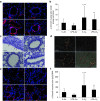Intra-amniotic LPS amplifies hyperoxia-induced airway hyperreactivity in neonatal rats
- PMID: 23563192
- PMCID: PMC3707085
- DOI: 10.1038/pr.2013.58
Intra-amniotic LPS amplifies hyperoxia-induced airway hyperreactivity in neonatal rats
Retraction in
-
Retraction Note: Intra-amniotic LPS amplifies hyperoxia-induced airway hyperreactivity in neonatal rats.Pediatr Res. 2019 Nov;86(5):677. doi: 10.1038/s41390-019-0529-y. Pediatr Res. 2019. PMID: 31481720 Free PMC article.
Abstract
Background: We previously showed that intra-amniotic lipopolysaccharide (LPS) amplifies alveolar hypoplasia induced by postnatal hyperoxia. We determined whether the priming effect of intra-amniotic LPS amplifies hyperoxia-induced airway hyperreactivity (AHR).
Methods: LPS or normal saline was injected into the amniotic cavities of pregnant rats at the 20th day of gestation. After birth, rat pups were exposed to 60% O₂ or air for 14 d. On postnatal day 14, rat pups underwent forced oscillometry, which included a challenge with nebulized methacholine, and the lungs were harvested for morphological studies.
Results: Hyperoxia significantly increased airway reactivity and decreased compliance. Intra-amniotic LPS further increased hyperoxia-induced AHR but did not further impair respiratory system compliance. Hyperoxia-induced changes in lung parenchymal and small airway morphology were not further altered by intra-amniotic LPS. However, combined exposure to intra-amniotic LPS and hyperoxia increased the proportion of degranulating mast cells in the hilar airways.
Conclusion: Intra-amniotic LPS amplified postnatal hyperoxia-induced AHR. This was associated with increased airway mast cell degranulation, which has previously been linked with hyperoxia-induced AHR. There were no morphologic changes of parenchyma or airways that would account for the LPS augmentation of hyperoxia-induced AHR.
Figures





Comment in
-
Findings of Research Misconduct.Fed Regist. 2019 Nov 7;84(216):60097-60098. Fed Regist. 2019. PMID: 37547121 Free PMC article. No abstract available.
Similar articles
-
Mast cells mediate hyperoxia-induced airway hyper-reactivity in newborn rats.Pediatr Res. 2010 Jul;68(1):70-4. doi: 10.1203/PDR.0b013e3181e0cd97. Pediatr Res. 2010. Retraction in: Pediatr Res. 2015 Apr;77(4):606. doi: 10.1038/pr.2015.18. PMID: 20386143 Free PMC article. Retracted.
-
[Increased apoptosis after intra-amniotic endotoxin priming plus hyperoxic exposure in lungs of preterm newborn rats].Zhonghua Er Ke Za Zhi. 2009 Oct;47(10):767-73. Zhonghua Er Ke Za Zhi. 2009. PMID: 20021812 Chinese.
-
Bronchopulmonary dysplasia in a rat model induced by intra-amniotic inflammation and postnatal hyperoxia: morphometric aspects.Pediatr Res. 2009 Mar;65(3):323-7. doi: 10.1203/PDR.0b013e318193f165. Pediatr Res. 2009. PMID: 19391205
-
[Effect of intra-amniotic endotoxin priming plus hyperoxic exposure on the expression of vascular endothelial growth factor and its receptors in lungs of preterm newborn rats].Zhonghua Er Ke Za Zhi. 2007 Jul;45(7):533-8. Zhonghua Er Ke Za Zhi. 2007. PMID: 17953812 Chinese.
-
Effects of antenatal lipopolysaccharide and postnatal hyperoxia on airway reactivity and remodeling in a neonatal mouse model.Pediatr Res. 2016 Mar;79(3):391-400. doi: 10.1038/pr.2015.232. Epub 2015 Nov 5. Pediatr Res. 2016. PMID: 26539665 Free PMC article.
Cited by
-
Repeated β2-adrenergic receptor agonist therapy attenuates the response to rescue bronchodilation in a hyperoxic newborn mouse model.Neonatology. 2014;106(2):126-32. doi: 10.1159/000362684. Epub 2014 Jun 20. Neonatology. 2014. PMID: 24969536 Free PMC article.
-
Anti-inflammatory effect of caffeine is associated with improved lung function after lipopolysaccharide-induced amnionitis.Neonatology. 2014;106(3):235-40. doi: 10.1159/000363217. Epub 2014 Jul 5. Neonatology. 2014. PMID: 25011471 Free PMC article.
-
Human amnion epithelial cells rescue cell death via immunomodulation of microglia in a mouse model of perinatal brain injury.Stem Cell Res Ther. 2017 Feb 28;8(1):46. doi: 10.1186/s13287-017-0496-3. Stem Cell Res Ther. 2017. PMID: 28241859 Free PMC article.
-
Airway Hyperreactivity Is Delayed after Mild Neonatal Hyperoxic Exposure.Neonatology. 2015;108(1):65-72. doi: 10.1159/000380758. Epub 2015 May 22. Neonatology. 2015. PMID: 26021677 Free PMC article.
-
Rodent models of respiratory control and respiratory system development-Clinical significance.Respir Physiol Neurobiol. 2019 Oct;268:103249. doi: 10.1016/j.resp.2019.06.006. Epub 2019 Jul 14. Respir Physiol Neurobiol. 2019. PMID: 31315068 Free PMC article. Review.
References
-
- Van Marter LJ, Dammann O, Allred EN, Developmental Epidemiology Network Investigators et al. Chorioamnionitis, mechanical ventilation, and postnatal sepsis as modulators of chronic lung disease in preterm infants. J Pediatr. 2002;140:171–6. - PubMed
-
- Choi CW, Kim BI, Hong JS, Kim EK, Kim HS, Choi JH. Bronchopulmonary dysplasia in a rat model induced by intra-amniotic inflammation and postnatal hyperoxia: morphometric aspects. Pediatr Res. 2009;65:323–7. - PubMed
-
- Husain AN, Siddiqui NH, Stocker JT. Pathology of arrested acinar development in postsurfactant bronchopulmonary dysplasia. Hum Pathol. 1998;29:710–7. - PubMed
-
- Tomashefski JF, Jr, Oppermann HC, Vawter GF, Reid LM. Bronchopulmonary dysplasia: a morphometric study with emphasis on the pulmonary vasculature. Pediatr Pathol. 1984;2:469–87. - PubMed
-
- Robin B, Kim YJ, Huth J, et al. Pulmonary function in bronchopulmonary dysplasia. Pediatr Pulmonol. 2004;37:236–42. - PubMed
Publication types
MeSH terms
Substances
LinkOut - more resources
Full Text Sources
Other Literature Sources

